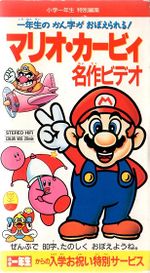Mario Kirby Meisaku Video: Difference between revisions
LinkTheLefty (talk | contribs) mNo edit summary |
Bowserbros (talk | contribs) mNo edit summary |
||
| Line 4: | Line 4: | ||
'''''Mario Kirby Meisaku Video''''' (マリオ・カービィ 名作ビデオ, lit. "Mario Kirby Masterpiece Video") is a Japan-only educational video starring [[Mario]] and [[Kirby]] in their own separate adventures. Its purpose is to teach Japanese children {{wp|Kanji|kanji}} (Chinese characters used in Japanese writing alongside the two syllabic {{wp|Kana|kana}} scripts, which are learned by children first, followed by the kanji). The film begins with two short stories featuring Mario and Kirby respectively, with still pictures on the left and kanji transcriptions on the right. It then goes over the kanji learned and has advertisements for a ''{{wp|Doraemon}}'' drawing kit and [[Yoshi]] camera, totaling a run time of 20 minutes. | '''''Mario Kirby Meisaku Video''''' (マリオ・カービィ 名作ビデオ, lit. "Mario Kirby Masterpiece Video") is a Japan-only educational video starring [[Mario]] and [[Kirby]] in their own separate adventures. Its purpose is to teach Japanese children {{wp|Kanji|kanji}} (Chinese characters used in Japanese writing alongside the two syllabic {{wp|Kana|kana}} scripts, which are learned by children first, followed by the kanji). The film begins with two short stories featuring Mario and Kirby respectively, with still pictures on the left and kanji transcriptions on the right. It then goes over the kanji learned and has advertisements for a ''{{wp|Doraemon}}'' drawing kit and [[Yoshi]] camera, totaling a run time of 20 minutes. | ||
Due to its obscurity, copies of the film can be extremely hard to find, especially outside of Japan. It was released for VHS in 1993 by [[Shogakukan]]. In addition to [[Nintendo]], [[HAL Labs|HAL Laboratory, Inc.]] is included in the copyrights because of the use of ''Kirby'' characters. The video is narrated by {{wp|Mayumi Tanaka}}, who also voices the characters.<ref>[http://web.archive.org/web/20120326111108/http://www.a-suma.com/video/mkmv.htm Kikaim] (Archived version from March 2012)</ref> Notably, this is the first piece of media in which Kirby is given a voice. It is also the only time [[Wario]] appears in an anime. | Due to its obscurity, copies of the film can be extremely hard to find, especially outside of Japan. It was released for VHS in 1993 by [[Shogakukan]]. In addition to [[Nintendo]], [[HAL Labs|HAL Laboratory, Inc.]] is included in the copyrights because of the use of ''Kirby'' characters. The video is narrated by {{wp|Mayumi Tanaka}}, who also voices the characters.<ref>[http://web.archive.org/web/20120326111108/http://www.a-suma.com/video/mkmv.htm Kikaim] (Archived version from March 2012)</ref> Notably, this is the first piece of official media in which Kirby is given a voice. It is also the only time [[Wario]] appears in an anime. | ||
==''Super Mario Story''== | ==''Super Mario Story''== | ||
スーパーマリオものガたり(Sūpā Mario Monogatari, lit. "'''''Super Mario Story'''''") is the ''Super Mario'' segment of the video. | スーパーマリオものガたり(Sūpā Mario Monogatari, lit. "'''''Super Mario Story'''''") is the ''Super Mario'' segment of the video. | ||
Revision as of 16:52, August 4, 2024
The title of this article is official, but it comes from a non-English source. If an acceptable English source is found, then the article should be moved to its appropriate title.
Mario Kirby Meisaku Video (マリオ・カービィ 名作ビデオ, lit. "Mario Kirby Masterpiece Video") is a Japan-only educational video starring Mario and Kirby in their own separate adventures. Its purpose is to teach Japanese children kanji (Chinese characters used in Japanese writing alongside the two syllabic kana scripts, which are learned by children first, followed by the kanji). The film begins with two short stories featuring Mario and Kirby respectively, with still pictures on the left and kanji transcriptions on the right. It then goes over the kanji learned and has advertisements for a Doraemon drawing kit and Yoshi camera, totaling a run time of 20 minutes.
Due to its obscurity, copies of the film can be extremely hard to find, especially outside of Japan. It was released for VHS in 1993 by Shogakukan. In addition to Nintendo, HAL Laboratory, Inc. is included in the copyrights because of the use of Kirby characters. The video is narrated by Mayumi Tanaka, who also voices the characters.[1] Notably, this is the first piece of official media in which Kirby is given a voice. It is also the only time Wario appears in an anime.
Super Mario Story
スーパーマリオものガたり(Sūpā Mario Monogatari, lit. "Super Mario Story") is the Super Mario segment of the video.
The treasure of a certain school has been pilfered by the "mysterious thief W". Princess Peach tells this news to Mario, who realizes that the thief is likely Wario. Mario searches for the thief in his Kart, but runs into several forest insects from Super Mario Land 2: 6 Golden Coins, including an Ant, a Beebee, and a Battle Beetle. This causes Mario to crash his Kart into a lake. After grabbing a Carrot and transforming into Bunny Mario, Mario leaps into the air and encounters Wario in his plane, the Bulldog. Wario reveals himself by taking off the mask over his eyes, and proceeds to fire at Mario using the Bulldog, causing him to fall back down. Untroubled by Wario's taunts, Mario uses a stick of bamboo to launch himself back into the sky and punch the Bulldog, much to Wario's dismay. Mario recovers the lost treasure, which is revealed to be a box full of comic books, and shows it to Princess Peach, having saved the day.
Kirby of the Stars
星のカービィ (Hoshi no Kābī, lit. "Kirby of the Stars") is the Kirby segment of the video. It shares its name with the name of the overall Kirby franchise in Japan.
Kirby finds a lost puppy, whose mother has disappeared. Kirby soon concludes that the mother is in the castle of his rival, King Dedede, and sets off to find the dog's parent. However, as it turns out, King Dedede was simply helping by putting a bandage on the mother's hurt paw. Kirby sighs, and the group has a big feast together in celebration of the mother's return.













